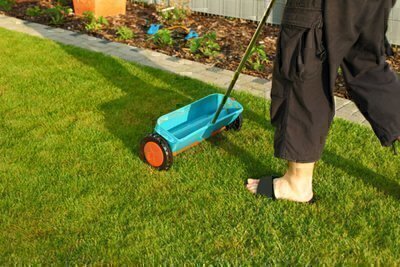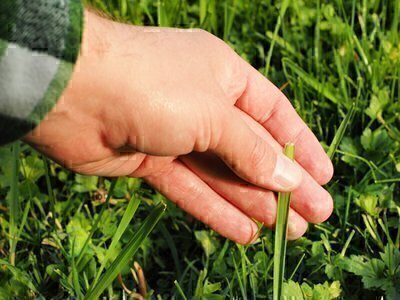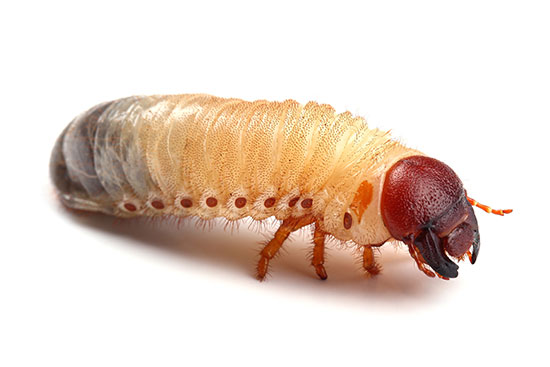What Do Lawn Care Services Do?
Last updated June 2021
If you're thinking about hiring a lawn care service, to choose the right company and level of service, you need to find out the range of services they offer.
Lawn care services work with different products, tools, techniques, and schedules, but the results they promise are similar from company to company.
Companies usually offer customers a selection of “packages” that include specified treatment plans to take place over the course of a year. Some lawn care services also offer one-time treatments, some automatically renew the contract each year, but almost all allow you to cancel a contract at any time and pay only for the visits you have received.
These are the most common types of lawn treatments, all of which you can do on your own if you don’t want to hire help.
 Aeration
Aeration
Most lawns benefit from a core aeration process once every three years or so. A device with metal tubes about one-half inch in diameter is rolled over your lawn, penetrating several inches into the turf to remove plugs of turf and soil, and then deposit them on the surface. The resulting holes admit water, air, fertilizer, and humus-creating organic matter to the root systems. The holes give the soil room to loosen, permitting easier root growth and better air and water circulation throughout the turf.
Because it’s labor-intensive, aeration is usually an add-on to lawn care service contracts, ordinarily costing more than $30 per 1,000 square feet of lawn. It’s a relatively simple job that you can do yourself by renting an aeration unit—which looks like a cross between a lawn mower and a tiller. If you’ve never operated one before, get some instruction from the tool-rental shop.
Seeding
Although it can be expensive, many lawns benefit from seeding (or “over-seeding”) each fall. New seed can fill in thinned-out areas, create a denser lawn that will discourage weeds and pests, add a newer grass variety with improved disease and insect resistance to an established lawn, or add a better grass variety for the area—for example, fine fescue can be planted in an area with dense shade, where tall fescue doesn’t grow well.
Some lawn care companies do limited seeding at no cost, but all charge for major jobs. If you want to do it yourself, make sure the seed comes into contact with the soil by using a rake to stir up soil underneath the lawn and applying a light topcoat of soil or compost after distributing the seed. Some lawn care services follow seeding with aeration.
 Fertilizing
Fertilizing
Applying fertilizer gives your lawn extra nutrients to improve its health. Most lawn care services recommend fertilizing three to six times per year, depending on need. But most of the grasses grown in this area benefit most from late summer or early fall fertilizations.
There are three basic types of fertilizer: fast-release synthetic, slow-release synthetic, and slow-release natural (organic).
A fast-release fertilizer gives grass a quick shot of nutrition, resulting in rapid leaf growth and greening. But this burst of growth may divert energy from the formation of a strong root system. A lawn that gets fast-release fertilizer five or six times per year may look good when the weather is good, but its weak root system may cause it to dry up later on.
Slow-release synthetic fertilizers give lawns a more steady and gradual supply of nutrients, but their disadvantage is that they don’t produce quick results—some formulations may produce no effects for weeks until weather conditions are ideal or they’ve been activated by nutrients in the soil. But the steady lower dose of nitrogen these fertilizers provide allows grass to build strong roots without sudden diversions of energy to leaf growth.
The third broad category of fertilizer types—natural, slow-release fertilizers—consists of all types that are not synthesized. Examples include dried blood, fish emulsion, manure, and processed sewage. These fertilizers are sometimes referred to as “organic,” a word used very loosely by lawn care companies eager to make sales. A more accurate term is “natural, nonsynthetic” fertilizers.
Like some synthetic slow-release fertilizers, all-natural fertilizers require action by soil microbes before nutrients become available to grass plants.
But natural fertilizers tend to be expensive, mainly because you may have to use up to four times as much of it as you do a synthetic.
If you apply fertilizer yourself, don’t assume more is better, especially with a synthetic. Since it’s really just a form of salt, too much synthetic fertilizer can “burn” your lawn, and excess fertilizer pollutes the watershed.
Maintaining Soil Acidity
Generously fertilizing your lawn can have little effect if its acid balance—pH reading—is not right. Your grass simply won’t be able to use the nutrients if the soil is too acidic or too alkaline. Most grass varieties grow best when the pH reading is between 6.5 and 7.0 (slightly acidic).
Many lawn care companies will test the pH level of your soil and apply lime, which reduces acidity, as needed. Some companies include this service in their basic packages; others add an extra charge. But because the soils of most lawns in this area naturally remain in an acceptable pH range, lime applications are rarely needed.
 Controlling Weeds
Controlling Weeds
There are several ways to control weeds.
Competition. The best way is to crowd out weeds with turfgrasses. A thick, strong lawn will have few weeds because the unwanted plants can’t compete. Mowing properly and seeding will help produce a nearly weed-free lawn.
Pre-emergent herbicides. You can apply an herbicide that kills seed sprouts; it’s what lawn care companies most commonly do to control crabgrass. After a lawn has been seeded, most types of pre-emergent herbicides must not be applied until the desired grasses have matured or the new grass will be killed or stunted (one type of pre-emergent grass herbicide, containing the ingredient siduron, can be used over newly seeded grass). Since you can’t know in advance exactly where weeds will appear, pre-emergent herbicides must be applied generally to broad areas that seem likely locations for weed grasses. While many lawn care companies treat every lawn in its entirety, some limit treatment to lawns that have a history of weed problems or even to vulnerable portions of such lawns.
Post-emergent herbicides. While no pre-emergent herbicides are in wide use for broadleaf weeds such as dandelions and clover, there are post-emergent herbicides that kill these plants without killing desired grasses. Some lawn care companies apply post-emergent herbicides all over every lawn to kill both visible plants and small not-yet-apparent plants. But many companies limit the application of these herbicides to lawns with a history of weed problems or currently visible weeds, and some treat only the portions of lawns where weeds are visible.
Physical removal. In small lawns with few weeds, physical removal is a reasonable option; use an asparagus knife to cut the roots. Many lawn care companies don’t offer this labor-intensive service.
Natural death. Weeds die off. If the problem isn’t too severe, just let nature take its course. In fact, that’s often the only practical option once weeds have matured.
When choosing a company, or deciding which of a company’s programs to choose, keep in mind that weeds are for the most part just wildflowers and grasses that have sprouted up in the wrong places. If you can live with a little wayward flora (consider them pops of color!), you may be able to avoid some expense, trouble, and exposure to herbicides.
 Controlling Insects
Controlling Insects
All lawns have some harmful insects; weather and other factors can create conditions where they can cause noticeable damage. Like weeds, many harmful pests prefer sunny areas. A thick, properly maintained lawn discourages widespread bugs, and most of this area’s turfgrasses are fairly resistant to most insect attacks.
Many lawn care services treat all of the yards they service with insecticides at times when insect damage is likely. This reduces the chances that a company will be called back between scheduled visits and reduces the risk that customers will be unhappy about losing portions of their lawns for the season.
But insecticides may kill beneficial organisms that prey on harmful insects and other harmful organisms. Insecticides may also harm earthworms, which contribute in other ways to the maintenance of healthy turf. Because of this, applying a hefty dose of insecticides can make a lawn more vulnerable than before the pest problem. From a community perspective, broad-scale use of insecticides may pose an additional risk to lawns—the risk that resistant strains of insects will develop.
To prevent companies from needlessly applying pesticides, insist that ones you deal with use a targeted control approach, or will agree to withhold pesticide treatments altogether. If a company plans to use pesticides, ask why, and whether it’s okay to skip it.
Controlling Disease
Most turf diseases are caused by fungi. Disease is most likely to occur in lawns that have been over-fertilized, improperly watered, cut too short, or otherwise subjected to stress. Weather conditions can up your chances of problems.
In most years, most lawns won’t experience serious disease problems. Most diseases that do occur are self-limiting, with the full damage often done by the time a disease is spotted. Because most lawns won’t benefit from fungicide treatment, and because the chemicals are expensive, lawn care companies and homeowners should seldom apply fungicides.
 Work You Still Have to Do
Work You Still Have to Do
Some lawn care services don’t offer mowing services; those that do usually sell it in a separate contract.
Mowing and watering properly is key to a healthy lawn:
- Don’t mow grass too short. Most local lawns should not be cut below a height of about 2½ to three inches.
- Mow often enough that no more than one-third of the blade is cut at a time.
- Keep your mower’s blades sharp to avoid tearing grass leaves, which makes them brown and vulnerable to pests.
- Mow when grass is dry.
- Leave clippings on the lawn so they can decompose and fertilize the soil, but spread out or remove big clumps.
Grass should be watered when leaves are just close to wilting; your grass is in the danger zone if you leave footprints when you walk on it.
In general, to keep grass green during the summer, make sure it gets about one inch of water per week; a rain gauge can help.


